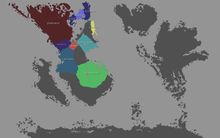Nation/Capisaria
| The Socialist Republic of Capisaria | |||
|---|---|---|---|
|
|||
Modern day Meridon.
|
|||
| Capital | Locoha | ||
| Largest city | Kijubi | ||
| Official languages | English, French | ||
| Recognised national languages | English, French, German | ||
| Demonym | Capisarian | ||
| Government | Democratic Republic | ||
| - | President | Jacques Vugo | |
| - | Prime Minister | Annalise Rubeck | |
| History | |||
| Area | |||
| - | Total | 700 904 km2 Expression error: Unexpected number. sq mi |
|
| - | Water (%) | 30% | |
| Population | |||
| - | estimate | 8 billion | |
| Currency | Meridonian Dollar (MRD) |
||
| Date format | dd ˘ mm ˘ yyyy (Era) | ||
| Calling code | 625W | ||
| Internet TLD | .cap | ||
Capisaria, officially the United Socialist Republic of Capisaria (french: La republique socialiste du Capisarie) is a sovereign and socialist nation in the continent of Parchu, located within the region of Meridon. Bordered to the north by the Valden Confederation, the northeast by Tallonius, and to the east by Ultimatus, the nation is in the central part of the continent, on the west coast.
It is a full member of the Meridon Union, which it was a founding member. The nation held the title of Interim Regional Delegate for a year, before peacefully handing the position to the first democratically elected delegate, elected under the regional constitution of 2023. Capisaria is one of the most populated countries in the region. The population was ranked in the top 5% of the world for most intelligent, longest life, as well as many other achievements. The population of the country maintains a democratic republic, in accordance with the country's Constitution of 1993. The government and people are one and the same. The country is divided in four levels of administrative organisation, with the National State (First Organisation) being the highest level, with the Congress of Capisaria, National Secretary, and High Tribunal all forming the Legislative, Executive, and Judicial branches, respectively. These divisions exist in order to efficiently and effectively maintain the cohesive structure of a nation, and all non-administrative actions may be reviewed by the populace via the process of National Review.
Contents
History
Prehistory
Archeological evidence suggests the earliest inhabitants of what is now the Capisarian nation was 500,000 years ago. The Capisarians were originally a small tribe of primitive warriors, warring with other tribes around them. History was rarely recorded, and only a handful of documented evidence gives us a view of what the Anciéns were like. The Meridonian continents were formed fairly later in the geological timeline, only in the beginning of the current era, the Holocene era.
Ancient
The Locohans were a Anglo-Capisarian tribe of hunter gatherers in the central part of what is now modern-day Capisaria. The term Locohan comes from murky origins, but is possibly connected to the since-extinct language of Locish. The current capital, Locoha, was the central part of what is believed to be early Locohan settlement.
Kingdom of Capisaria
Establishment The Kingdom of Capisaria was established in what is now referred to as year 30 of the Gredonian Calendar (GC). The tribe of Locohans had began spreading out, inhabiting a wider land range. The sea, located 93 kms west from what is now Locoha, was reached in this year. The tribal council quickly set up a fishing post there. At this point, the council also agreed to set out to establish a Supreme Chief, who would rule with shared authority with the council until death, or unless the council voted to remove him. The Chief would be drawn from the Royal Council, to consist of each former chief of the known Anglo-Capisarian Tribes.
First Contact For the Kingdom's early years, until year 43 GC, the tribe lived in complete isolation from the rest of the world. The central location of the Kingdom was only one of many Anglo-Capisarian tribes. Encountering the surrounding tribes finally, the Kingdom found itself decades ahead in technology and societal development than its surroundings.
Empire of Capisaria
Republics of Capisaria
Unification and Federation
Revolution and The Socialist Paradigm
Geography
Transportation and Infrastructure
Capisarian infrastructure is widely heralded as some of the most innovative and beautiful in the region. Capisaria also maintains the most extensive road network in the region, and it's high speed rail network connects all major cities, capitals, and administrative divisions, and connects to several neighboring countries.
Roads
Trains
Today, all passenger trains in Capisaria are high-speed state-of-the-art lines, connecting 90% of the geographic landmasses claimed and administered by Capisarian authorities, and frieght transportation via rail is the number one way of moving large goods large distances. Over 150,000 kilometres of 1,435 mm gauge track cover the Capisarian nation.
Passenger
All passenger trains in Capisaria are operated either wholly or partly by the 51% government owned corporation, CapiRAIL. In 1992, the revolutionary government moved to consolidate local and national rail businesses, with the enactment of the Revolutionary Decree on the Privilege of Transport, in which 4 privately run companies, as well as numerous smaller local lines, were seized (sometimes with no compensation) by the government and appropriated into CapiRAIL, which was originally the largest of these private companies.
Starting in 1993, one of the final acts of the provisional government was to enact the first Charter of CapiRAIL, stipulating that in exchange for limited government funding, the company would not charge for more than the cost of maintaining, running, and upgrading the train system with a 10% profit rate. Valid for ten years, these ten years saw the company repair and upgrade the existing rail network, as well as its first experimentation with high speed rail. The focus of the company also saw the integration of the national networks, as well as the connections with regional local lines.
After the first charter expired, the company entered into negotiations with the Council of Unions, where the 2nd Charter was adopted, in conjunction with a bill that placed the company under direct management of the Council of Unions, replacing the former board of directors. The board had been recently accused of Federalist tendencies, like neglecting rural lines and charging more than the allowed 10% rate. Valid for 10 years again, the company entered a period of relative stability. Usage steadily increased, and the company began negotiations to enter neighboring countries, either extending existing lines or contracting with domestic companies.
In 2013, the passage of the partial-privatization bill during a brief stint of power from the Restorationist Party saw the negotiations for the new charter take place in the chambers of the three legislative assemblies, where the Council of Unions and the Senate were outnumbered by the National Assembly. The Restorationists imposed massive changes to the structure of the company, including reinstating the Board of Directors. The company's stock was also made public, with the government maintaining a 20% minimum share. This charter also shifted away from maintaining the transport for the public good, but rather the profits of the Board. 2 members of the board would be from the Engineer's Union. Prices rose, but not more than twice the previous amount. The 3rd Charter saw the finalization of all contracts with neighboring nations, and midway through, the passage of the High Speed Rail Act caused the company to begin refitting all of its national lines to be capable of running at a maximum speed of 560 km/h.
In 2023, the government had returned to control of the Socialist Worker's Party. The Capisarian Prime Minister, Annalise Rubeck, pushed for a normalization of the renewal process. The 4th Charter was the first one to be put forward for nationwide vote. It reinstated the Council of Unions as a power in management, but only placed it in charge of the costs and maintenance part of the company, and the Board of Directors remained in charge of the day to day running of the company. The government also purchased back stock, and its share was locked in at 51%. Profit rate was set to be no more than 30%, but employees' pay was shifted from wage based to be a share of the profit proportionate to their level within the company, except if the company was in financial trouble. An act was also passed that broke the company's monopoly on high-speed rail, and several of its local lines were sold off to public companies owned by states/provinces and départements, on the condition that those companies allow 10% of each of their stock to be owned by CapiRAIL. Finally, it was made that all future charter negotiations take place in the National Assembly, but voted on by the Senate. The Council of Unions would not have a role on voting, but would be in charge of negotiating for the company in conjunction with the Board.




